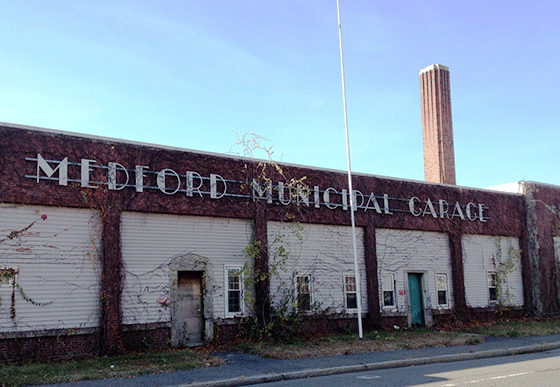Municipal Garage a Faded New Deal Landmark
– Ken Krause
Mostly condemned and all but abandoned, the Medford Department of Public Works yard on James Street is facing an inglorious end as the city prepares to raze it this spring and construct a 21st century facility.
Windows broken, doors padlocked and walls overgrown with ivy, the building’s state not only belies its more useful days but also conceals its rightful place in Medford history as one of the edifices that helped usher the city out of the throes of the Great Depression.
The Medford Municipal Garage, its original name, was one of four significant structures built in about a half-mile radius of Medford Square in the late 1930s. Each of them came about because of the New Deal, the federal government economic stimulus program, and in particular the Works Progress Administration (WPA), the agency that put millions of unemployed people to work on public works projects.
Three of the landmark buildings were dedicated in just a two-week span in 1937: the Municipal Garage on Sept. 1; City Hall on the old Medford Common on Sept. 11; and the U.S. Post Office on Forest Street on Sept. 15. The fourth, Chevalier Auditorium, would open in March 1940 next to the post office.
The New Deal building boom had Medford bursting with civic pride. The opulent City Hall capped a nearly 50-year quest to provide a suitable headquarters for city agencies, which had been scattered about town for decades. In an article about the new public buildings, the Medford Historical Register of September 1937 said City Hall was “acknowledged to be one of the finest structures of its kind in the United States for a city of its size,†and called the post office “one of the best of its kind†and “a credit to the city.â€
Meanwhile, just across the Mystic River now stood the municipal garage, which the Register deemed “one of most modern plants of its type in the country†and “a monument to Medford’s progress.†It replaced the nearby “city stable,†a 30-year-old facility that had become inadequate as motorized equipment replaced horsepower. The low-slung, Pentagon-style structure covered 31,471 square feet of a 69,405-square-foot property and housed 150 trucks and other pieces of equipment.
The building cost $219,629, with Medford paying $79,486 for materials and engineering and the federal government paying the rest. All work was performed by WPA labor, according to the Register.
Today, City Hall, the post office and Chevalier Auditorium continue to serve the city quite well. But the soon to crumble municipal garage will not be completely forgotten. City officials have requested that demolition contractors preserve for future use the large art deco-style “Medford Municipal Garage†sign and concrete city emblem that grace the east side of the building along Mystic Valley Parkway.
The Medford Historical Commission also has expressed interest in documenting the building before its demise. Any project that requires funding, licenses or permits from any federal or state agency requires review for compliance with the National Historic Preservation Act of 1966 and/or review by the Massachusetts Historical Commission.
The Medford Historical Commission is hopeful that there will be an opportunity to both record the architectural details of the building before it is torn down, and preserve some of its more notable elements, such as the “Medford Municipal Garage†sign and city seal, says James Kossuth, chairman of the Historical Commission.

The art deco sign.

The city seal.